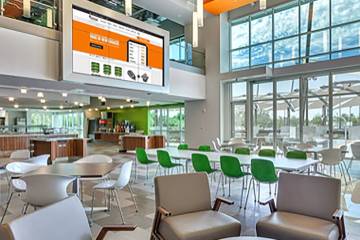The Southern Nevada economy will continue to grow in 2017 and 2018, but at a slower rate than previous years because of the sluggish growth of the national economy, according to a UNLV economics professor.
Dr. Stephen Miller, director of the Center for Business and Economic Research, released his fourth quarter report Dec. 13 to business executives and academia during the annual Economic Outlook Conference at the M Resort. The positive from Miller and his report is that Nevada will continue to outgrow the national economy as a whole, even if the rate is subdued and isn’t as high as recent years.
“People should expect continued growth and continued improvement in the economy but nothing that’s too rapid a pace,” Miller said. “We’re still improving but not as much in previous years.”
Miller said Southern Nevada’s visitor volume, which is on pace to set a record in 2016, will grow at 1.7 percent in 2017 and less than 1 percent in 2018. He projects the region will finish 2016 with a 2 percent growth rate, which is below the 2.9 percent gain in 2015 and 3.7 percent gain in 2014. Gross gaming revenue should grow by 1.3 percent in 2017 and by 1.2 percent in 2018.
The region’s employment will grow 2.7 percent in 2017 and 2.5 percent in 2019, down from 3.2 percent in 2016. It grew by 4.7 percent in 2014.
Personal income will rise 3.9 percent in 2017 and 3.8 percent in 2018, after increasing 4.2 percent in 2016, Miller said. It rose 4.7 percent in 2015 and 5.9 percent in 2014.
Miller said no one should be worried about the slight declines in growth over the next year or two. Southern Nevada has made a lot of progress after it emerged from last decade’s Great Recession.
“We’re growing at a rate that makes it one of the leading in the country, but we were so far behind that it looks like we are not making as much progress,” Miller said.
What’s prompting Miller to lower growth rates compared to what Southern Nevada experienced in recent years is the business cycle in the national economy is maturing. Economists are predicting GDP will grow slightly more than 2 percent but less than 2.5 percent in 2017. Miller and CBER project GDP will be 2 percent or less.
President-elect Donald Trump said he wants GDP to grow at least 4 percent during his presidency, and Miller said he would be ecstatic if the growth rate fell between 2.5 percent and 3 percent. That will take time for policies enacted to impact the economy, he said.
“We will see in the new administration whether they can pump the growth rate up,” Miller said. “I’m skeptical that will happen. We’re scheduled for slow growth. If we got 2.5 to 3 percent, that would be an accomplishment.”
Miller said the policy proposals by Trump and other Republicans in Congress would help the economy. An infrastructure program that spends hundreds of millions of dollars would help stimulate the economy and raise GDP without requiring continued payments that would be a constant drag on the annual deficit, he said.
Cutting regulations on businesses and lowering the corporate tax rate would aid the economy. That would help lure companies to bring back money parked overseas and spur more investment in the U.S., Miller said.
“That’s had a (positive) impact in the past,” he said.
A cut in high-end tax rates would spur investment as well, while a cut in tax rates for middle-income Americans would spur consumption and spending on goods and services.
“There’s a lot of uncertainty about what’s going to happen.” Miller said. “There are a lot of tweets out there (from Trump) and to be optimistic about the whole process, the tweets are an exaggeration. The policies are going to be more reasonable. No matter what, I don’t think there’s any way you can get more than 4 percent growth. You can say that, and I think it’s a great goal, but you’re not going to get there.”
The report cites the other typical risks for Nevada’s economy such as a terrorist attack and international economic conditions, but highlights specifically the role of the Federal Reserve and raising interest rates.
“If the global economy and national economy slows down that’s not good for us,” Miller said. “We need to look at what is the schedule of interest rate changes and fiscal policy that’s being tweeted about.”
The report suggests there will be two rate increases in 2017 and two more in 2018, which would leave the federal fund rate at 1.5 percent by the end of 2018.
“Fewer interest rate increases could lead to higher inflation, whereas more interest rate increases could lead to slower growth,” the report said.
The report also delves into the Southern Nevada commercial real estate market and suggested the Great Recession may have created “permanent changes in the normal vacancy rates” in some categories. That includes the office vacancy rate lingering about 20 percent and retail vacancy rate near 10 percent.
“Does this vacancy rate of around 10 percent represent a new normal?” the report asked. “Only time will tell.”
Housing permits, which Miller said will finish 2016 with a 21 percent gain, will increase less than 1 percent in 2017 and 10 percent in 2018. There are positives, however, since the population should grow by more than 2 percent over the two years and increase demand and spawn economic activity.
“Housing is still pretty affordable (in Las Vegas and Phoenix) and not so affordable in California, and we’re back in a situation where we will see people in California retiring and moving to Phoenix or Las Vegas.”
Clark County continues to make gains in construction employment decline to 35,000 from its peak of 105,000 before the recession. That number has surpassed 59,000.
“There’s been a lot of recovery but one anticipates we’re going to go back to that level,” Miller said.






